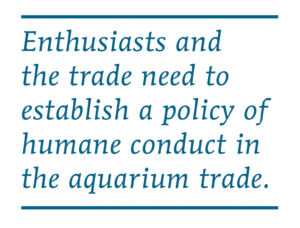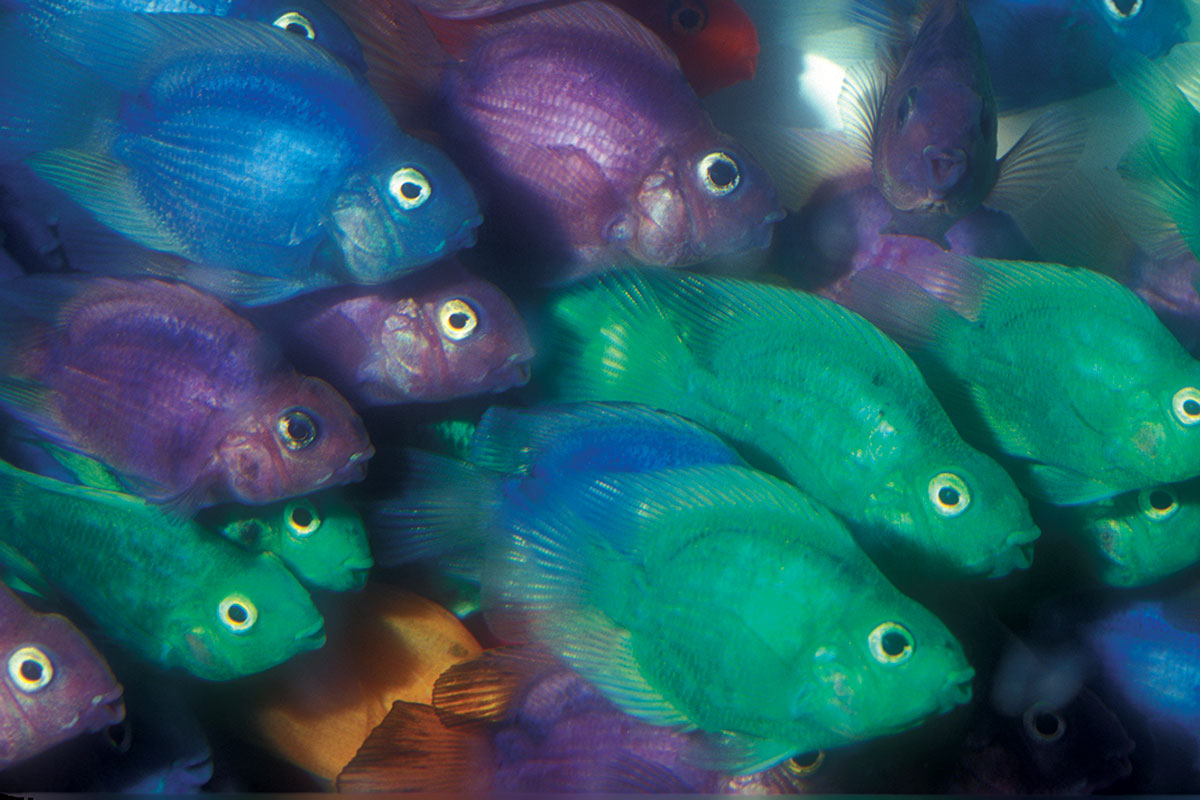
Dyed parrot cichlids have been dipped in a caustic solution to strip their slime coats, then into a dye solution, and finally into a chemical that stimulates slime production. Colors are temporary. Photo: O. Lucanus
A special excerpt from the September/October 2019 issue of AMAZONAS Magazine, by Stephan Tanner, Ph.D.
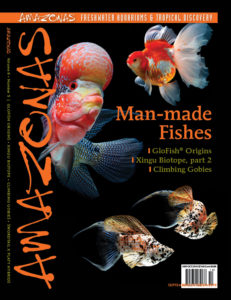
An excerpt from the September/October 2019 issue of AMAZONAS Magazine, MAN-MADE FISHES. Click to order the back issue!
“Man-made animals” have become a controversial topic over the past two or three decades. While humans have domesticated animals for the better part of some 15,000 years (MacHugh et al., 2016), the topic has turned into a heated debate between widely opposing sides. Unfortunately, rather than offering an informed discussion that expands everybody’s horizon, many critical voices just deplore such specimens without qualifying their stand. Proponents meanwhile simply disregard the critics or worse. My reason for devoting an issue of AMAZONAS to this topic is based on the realization that we have to discuss it, because man-made fishes have been around for a long time and are here to stay, just think of koi (Cyprinus carpio) or goldfish (Carassius auratus). If we do not cover man-created strains and forms, and debate the Good, the Bad, and the Ugly, we leave the field to emotional grandstanding or worse, legal regulations without qualified input.
Man-made fishes and shrimps now come in a variety of forms, and I group them here in four broad categories based on how they have come into being:
Mutants: organisms selected for certain traits from spontaneous or induced mutations (albino, color, fin, or body shapes), such as countless strains of goldfish, koi, guppies, long-finned bristlenose plecos, barbs, tetras, balloon mollies and balloon blue rams, and crippled rainbowfish and gouramis, etc.
Hybrids: the offspring resulting from crosses between species or populations. Examples now omnipresent in the trade include flowerhorns, parrot cichlids, bettas, angelfish, discus, platies, swordtails, and Taiwan and bee shrimps.
Genetically modified fish (GMO): transgenic fish (aka GloFish®) have entered the market as barbs, tetras, danios, and sharks.
Physically modified fish: physically altered and tortured by tattooing, dyeing, cutting, or painting.
The Good:
At least among the mutants and hybrids, there are strains that are well established and hardly make anyone cringe: for example, wagtail platies, coral swordtails, black harlequin rasboras (Trigonostigma heteromorpha), or gold barbs (Barbodes semifasciolatus).
Interestingly, flowerhorns caused an uproar upon entering the trade, yet many devoted enthusiasts happily breed fancy swordtails, angelfish, or shrimps. Maybe they are unaware that the vast majority of fancy platies and swordtails are the product of crossing Xiphophorus maculatus with X. hellerii or X. variatus many generations ago. Or that many domestic angelfish are crosses of various local populations or species. The same is true for domestic discus strains and many fancy shrimp forms.
GloFish carry various color genes from jellyfish and other sources, but otherwise these fish are genetically “normal”, in many cases actually less aberrant from the wild fish than many mutants or hybrids. Demonized by many as the end of fish keeping, they are quite popular among kids. I view them the same way my parents regarded comic books when I was a kid. While my comics were not the best literature, at least I learned to read. Ultimately, I graduated to more sophisticated literature and magazines. Hence, if a youngster fancies a tank with GloFish danios or barbs, let it be! Almost every single one will graduate to “real fish” down the road. And for a hobby that notoriously lacks beginners, we could surely use a little man-made help.
Ultimately, as long as the animal swims normally and can exhibit its behavioral repertoire, creating man-made strains from mutations and crosses poses no ethical dilemma. Hybrids, however, should be clearly labeled as such and not sold as new species or forms of existing species. This is especially true for rainbowfish species which cross easily, resulting in hybrids that are difficult to tell apart. Thus, great care is necessary to keep wild lines pure, and honest disclosure is a must.
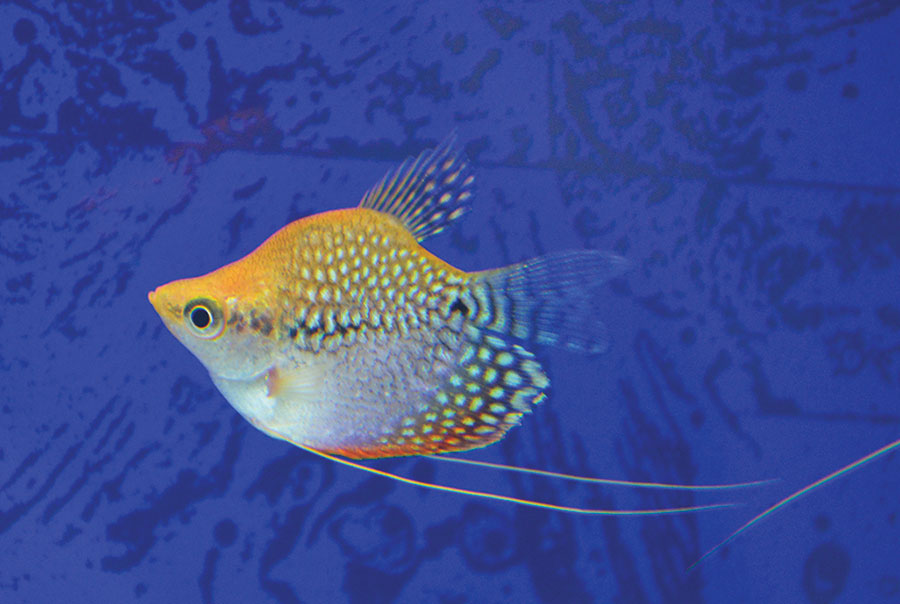
This balloon pearl gourami (Trichopodus leerii), has been selectively bred for its deformed spine. Photo: H.-G. Evers
The Bad:
While many mutants or hybrids are a matter of taste, there are some with abysmal distortions (ballooning, crippled vertebrae, skull deformations) that can hardly swim. Some parrot cichlids are so deformed that they have trouble eating. Then there are stingrays with partially missing disks, the so-called bat-rays. Most of these horror-show participants are produced in Asia where there is a large market for these grotesque animals. In my opinion, the trade should abstain from importing and marketing such extreme breeds.
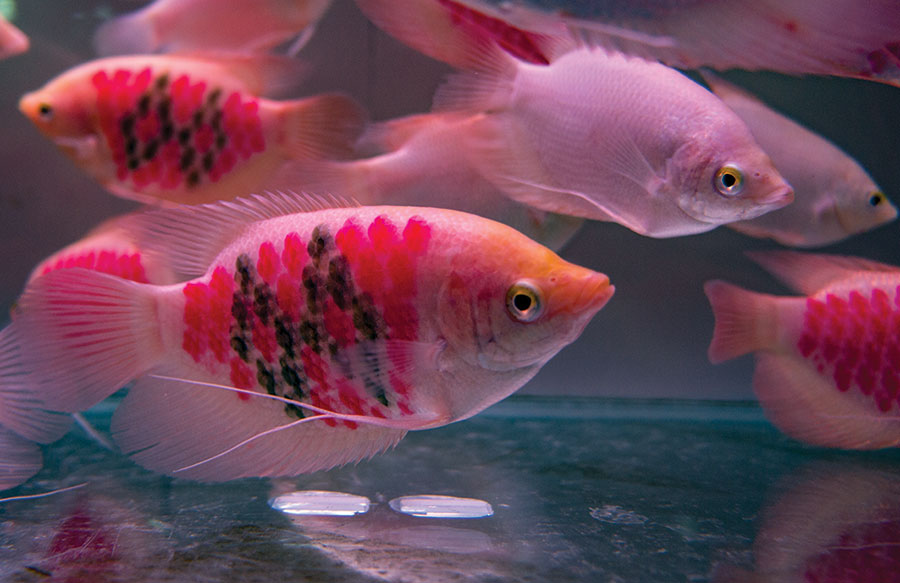
Tattooing words and symbols with needles or lasers injures fish, such as these juvenile giant gouramis (Osphronemus goramy). Photo: O. Lucanus
The Ugly:
I should not need to spell it out, but dyed, tattooed, or otherwise tormented fish have no place in the hobby. Physical modification on live animals is in no way justifiable and violates basic animal welfare. Some extreme breeds of goldfish also belong to what I call “torture breeds”, although goldfish enthusiasts will counter that, with the correct care, they can do just fine. Luckily, some of the fanciest strains are not hardy enough for the mainstream trade, hence remain limited to connoisseurs.
Setting Rules and Limits
The above examples show that there is no categorical “right” or “wrong”, unless the animal suffers from man-made physical modifications. Enthusiasts and the trade need to come together to establish a set of moral and ethical rules, call it a policy of humane conduct in the aquatic trade. This is far better than restrictive laws and regulations that are nearly impossible to enforce. GloFish are illegal in Europe, yet available, if you know where to look. Sound familiar? By the same token, we have not managed to root out illegal drugs despite wasting billions of dollars. Accordingly, only a genius believes a black fish market could be outlawed and effectively controlled.
As hobbyists and trade partners, we must go ahead in setting limits. If we don’t, someone else will and we are very likely not going to welcome such restrictions. We are the experts who know what it takes to keep our animals healthy; we know their requirements, and we know what hurts them. Consequently, we are in the best position to propose reasonable rules, limits, and if necessary, write the laws that regulate the aquatic trade. We here at AMAZONAS Magazine welcome discussion and correspondence on the topic of man-made fishes. With that, I leave you to indulge in the best hobby in the world.
Reference
MacHugh, D.E., G. Larson, and L. Orlando. 2016. Taming the past: ancient DNA and the study of animal domestication. Annual Review of Animal Biosciences 5: 529-351.

